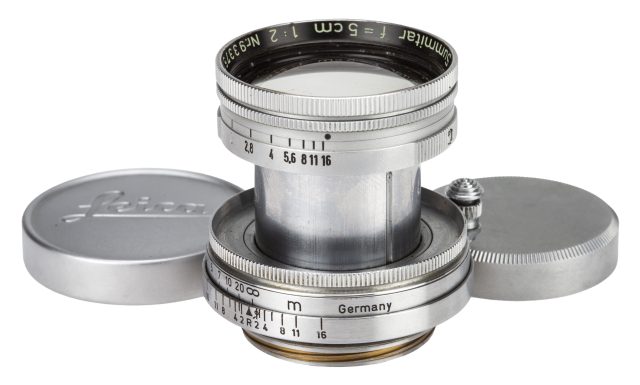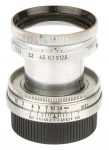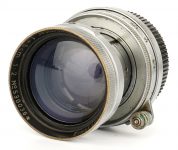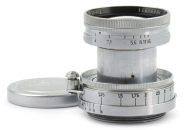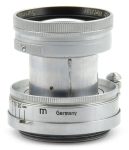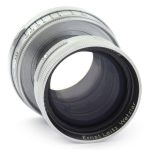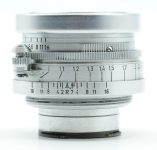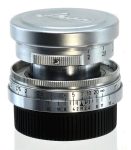Announced
Production status
Order No.
System
Pros and cons
Genres or subjects of photography
Recommended slowest shutter speed when shooting static subjects handheld
Leitz / Leitz Wetzlar Summitar 50mm F/2
Standard prime lens • Film era • Discontinued
Model history
Specification

| Optical design: | |
| 50mm | |
| F/2 | |
| 35mm full frame | |
| Leica screw mount | |
| 46.8° (35mm full frame) | |
| 7 elements in 4 groups | |
| Diaphragm mechanism: | |
Diaphragm type: | Manual |
Aperture control: | Aperture ring |
| <No data> | |
| Focusing: | |
Coupled to the rangefinder: | Yes |
| 1m | |
Focusing modes: | Manual focus only |
Manual focus control: | Focusing lever |
| Physical characteristics: | |
| 240g | |
| ⌀47.8×42.7mm | |
| Accessories: | |
| Screw-type 36.4mm | |
| SOOPD / 12515 | |
| ORSTO / 14030 (front) | |
| ORSUM / 66846 (front) | |
| FIRHU / 35252 / 66835 (rear) | |
| ORYFO / ORYFOCHROM / 14050 (rear) |
Source of data
- Leica lenses booklet (PUB. 1356) (March 1950).
Manufacturer description #1
The faster objective, Summitar 50mm., f/2 (2"), angle 45 deg., is based on the so-called Gauss-type, which affords excellent correction possibilities for higher relative aperture and for greater angles of view. At variance with the normal Gauss type, the front member is composed of two lenses, so that additional means of correction are obtained. The excellent color correction deserves special mention, whereby color defects of a higher order are made unnoticeable.
The other defects, too, are limited in their extent. With reduced aperture the sharpness of the image increases rapidly and reaches its maximum at about f/5.6. Special importance was attached to the extensive elimination of vignetting which is of fundamental importance, especially in color photography.
Manufacturer description #2
From the LEICA photography magazine (Christmas 1950, Vol. 3, No. 12):
The use of seven lens elements in this construction provides better control of off-axis aberrations and it has been possible to reduce vignetting by increasing the diameters of the components beyond those required for the axial beam alone. The provision of adequate illumination in the corners of the negative is now recognized as a primary requirement in all lenses that may be used with color film, and future trends in lens design will be largely influenced by this factor. The spherical aberration of the Summitar is well corrected, amounting at its maximum to about 0.25% of the focal length - almost half that of the Zeiss f/2 Sonnar. There is little or no astigmatism over the field covered by a 50mm. lens but the undercorrected field curvature is necessary to counteract appreciable overcorrection of a special form of coma known as oblique spherical aberration.
Manufacturer description #3
From the diameter of the front element of the Summitar lens, one would be led to believe that its aperture is about F:1.6. In spite of this, the effective aperture remains F:2 and this means that the increased amount of light transmitted by the larger front element has the effect of considerably reducing the falling off in illumination at the edges of the field. In other words, the lens gives even intensity of illumination at the edges of the image. This is of great advantage, particularly in color photography. While it is always possible to reduce the vignetting effect in a lens by increasing the diameter of the front element, this is usually done by a sacrifice in definition at the edges of the field. In the Summitar lens, however, the increased marginal intensity of illumination is not accomplished by a sacrifice in definition; on the contrary, we have improved the correction of the Summitar lens to such an extent that, in spite of the increased marginal intensity of illumination, a considerable improvement in definition over the entire area has been accomplished, even at full aperture.
Another advantage of the Summitar lens lies in the fact that the large front element of this new objective is made of a new type optical glass which protects the lens surface very effectively against adverse climatic conditions such as encountered in the tropics or in humid atmospheres.
When using the Summitar lens, it is of utmost importance to eliminate all possibility of stray light from entering the lens and causing flare or halation on the film. Therefore the Summitar lens should always be used with the collapsible sunshade which has been specially designed for it. This is especially true when the full, or nearly full, aperture of the lens is utilized, even on occasions where photographs are being taken in artificial light or out of doors without sunshine.
The advisability of using a sunshade refers to all photographic lenses.
In general, the same rule applies to the Summitar lens which applies to all high speed photographic lenses. The full aperture should serve as a reserve of speed for such cases where unfavorable lighting conditions would make it necessary to use exceedingly long exposure times; where a short exposure time is necessary because of a too rapid movement of the object, or where it is desirable to use a differential focus, in order to reduce confusing background detail in portraiture.
The Leitz Summitar lens is collapsible and equipped with the standard type focusing mount with depth of focus scale and coupling for the range finder of the Leica camera. When stopped down to F:6.3, the Summitar lens may be used for enlarging. For close up photography and short distance work, the Summitar lens may be used with the Optical Short Distance Focusing Device (Nooky-Hesum).
Manufacturer description #4
From the LEICA photography magazine (Christmas 1950, Vol. 3, No. 12):
LEICA LENS RENDITION... There have been numerous customer inquiries as to the reason for the difference in color rendition between the various types of Leica lenses. There are two distinct groups, namely the Elmar type (Elmar 50, Elmar 90) and Summitar type (Summitar 50, Summaron 35). In photographic literature, mention is made of lenses with a "cold" color tone and those with a "warm" color tone.
Our Elmar and Summitar groups fall into these same categories. The reproduction on color film with the Elmar could be classified as "cold" while the Summitar group renders color images which have a "warm" tone.
The reason is that the Elmar type lenses, with standard crown and flint glass which is clear white, permit the transmission of the entire visible spectrum. The other lens system, namely Summitar and Summaron, is partially constructed of the dense crown and dense flint glass required to achieve the maximum optical correction. Dense crown and dense flint glass have a very faint, yellow color so that a portion of the spectrum, specifically in the short wave length, is absorbed. The light that is actually transmitted, therefore, renders a warmer color which can easily be recognized when comparing photographs taken at the same time and of the same subject with the Elmar and Summitar lenses respectively.
Manufacturer description #5
From the LEICA photography magazine (Spring 1952, Vol. 5, No. 1):
The resolving power of Leica lenses is in excess of the resolving power of any commercially available 35mm. film. All Leica lenses are well corrected both chromatically and spherically, and you will notice no difference in the resolution when taking black-and-white or color. We are asked many times how the Elmar 50mm. and Summitar 50mm. lenses compare as to sharpness. For all practical purposes, they are equally sharp at the same apertures.
From the editor
Coated since November 1945.
Originally the lens featured the European aperture scale: 2, 2.2, 3.2, 4.5, 6.3, 9, 12.5, but the international aperture scale was introduced in 1946: 2, 2.8, 4, 5.6, 8, 11, 16, from No. 601001.
The number of aperture blades could be 6 or 10.
The lens uses special screw-in 36.4mm (type "L") filters. 42mm (type "O") filters can also be used by means of the adapter SNHOO / 13078.
Collapsible lens hoods SOOPD and SOOFM served as a lens cap when folded. There were clamp-on with set-screw and clip-on variants of SOOPD lens hood.
Notes
- All LEICA lenses having a focusing lever are automatically locked at the infinity position. This feature enables the camera to be used for infinity scenes and subjects without danger of the lens becoming accidentally out of focus due to unintentional movement. To release the lever for focusing on nearer planes press the knob at the end of the lever.
Other standard prime lenses in the Leica SM system
Sorted by focal length and speed, in ascending order
| ■Leica screw mount (11) | |||||||||
| Leitz Elmar 50mm F/3.5 [I] [ELMAR, ELMARKUP, ELMARCHROM] • Collapsible | M | 4 - 3 | 1.00m | A36 | 1930 ● | ||||
| Leitz Elmar 50mm F/3.5 [II] [ELMAR] • Collapsible | M | 4 - 3 | 1.00m | A36 | 1951 ● | ||||
| Leitz Wetzlar Elmar 50mm F/3.5 [III] [ELMAR / 11010] • Collapsible | M | 4 - 3 | 1.00m | E39 | 1954 ● | ||||
| Leitz Wetzlar Elmar 50mm F/2.8 [I] [ELMOO / 11512, ELMOO / 11012] • Collapsible | M | 4 - 3 | 1.00m | E39 | 1957 ● | ||||
| Leitz Hektor 50mm F/2.5 [HEKTO, HEKTORKUP, HEKTOCHROM] • Collapsible | M | 6 - 3 | 1.00m | A36 | 1931 ● | ||||
| Leitz / Leitz Wetzlar Summar 50mm F/2 [SUMAR, SUMARKUP, SUMARCHROM] | M | 6 - 4 | 1.00m | A36 | 1933 ● | ||||
| Leitz / Leitz Wetzlar Summar 50mm F/2 [SUMUS, SUMUSKUP, SUMUSCHROM] • Collapsible | M | 6 - 4 | 1.00m | A36 | 1934 ● | ||||
| Leitz Wetzlar Summicron 50mm F/2 [I] [SOOIC / 11016] • Collapsible | M | 7 - 6 | 1.00m | E39 | 1953 ● | ||||
| Leitz Wetzlar Compur-Summicron 50mm F/2 (150 units) | M | ? - ? | 1.00m | 1954 ● | |||||
| Leitz Wetzlar Xenon 50mm F/1.5 [XEMOO] | M | 7 - 5 | 1.00m | A51 | 1936 ● | ||||
| Leitz Wetzlar / Leitz Canada Summarit 50mm F/1.5 [SOOIA / 11020] | M | 7 - 5 | 1.00m | E41 | 1949 ● | ||||
Lenses with similar focal length
Sorted by manufacturer name
| ■Leica screw mount (36) | |||||||||
| Canon 50mm F/1.2 | M | 7 - 5 | 1.00m | ⌀55 | 1956 ● | ||||
| Canon 50mm F/1.4 I | M | 6 - 4 | 1.00m | ⌀48 | 1957 ● | ||||
| Canon 50mm F/1.4 II | M | 6 - 4 | 1.00m | ⌀48 | 1959 ● | ||||
| Canon 50mm F/1.5 | M | 7 - 3 | 1.00m | S.VII | 1952 ● | ||||
| Canon Serenar 50mm F/1.8 I | M | 6 - 4 | 1.00m | S.VI | 1951 ● | ||||
| Canon 50mm F/1.8 II | M | 6 - 4 | 1.00m | S.VI | 1956 ● | ||||
| Canon 50mm F/1.8 III | M | 6 - 4 | 1.00m | ⌀40 | 1958 ● | ||||
| Canon Serenar 50mm F/1.9 • Collapsible | M | 6 - 4 | 3.5 ft. | S.VI | 1949 ● | ||||
| Canon 50mm F/2.2 | M | 5 - 4 | 1.00m | ⌀40 | 1961 ● | ||||
| Canon 50mm F/2.8 I | M | 4 - 3 | 1.00m | S.VI | 1955 ● | ||||
| Canon 50mm F/2.8 II | M | 4 - 3 | 1.00m | ⌀40 | 1957 ● | ||||
| Chiyoko Super Rokkor 45mm F/2.8 [C] | M | 5 - 3 | 1.00m | 1947 ● | |||||
| Chiyoda Kogaku Super Rokkor 50mm F/1.8 | M | 6 - 5 | 1.00m | ⌀46 | 1958 ● | ||||
| Chiyoko Super Rokkor 50mm F/2.8 [C] | M | 5 - 3 | 1.00m | ⌀40.5 | 1954 ● | ||||
| Chiyoko Super Rokkor 50mm F/2 [C] | M | 7 - 6 | 1.00m | ⌀43 | 1955 ● | ||||
| Chiyoko Super Rokkor 50mm F/2 | M | 7 - 6 | 1.00m | ⌀40.5 | 1955 ● | ||||
| Cosina Voigtlander Color-Skopar 50mm F/2.5 LSM | M | 7 - 6 | 0.75m | ⌀39 | 2002 ● | ||||
| Cosina Voigtlander Heliar 50mm F/2 LSM “Cosina 50th Anniversary, Bessa 10th Anniversary” (600 units) | M | 5 - 3 | 1.00m | ⌀39 | 2009 ● | ||||
| Cosina Voigtlander Nokton 50mm F/1.5 Aspherical LSM | M | 6 - 5 | 0.90m | ⌀52 | 1999 ● | ||||
| Fuji Photo Film Fujinon 50mm F/1.2 | M | 8 - 6 | 3.5 ft. | 1954 ● | |||||
| Konica Hexanon 50mm F/2.4 LSM (1000 units) • Collapsible | M | 6 - 4 | 0.80m | ⌀40.5 | 1997 ● | ||||
| Nikon Nikkor-H·C 50mm F/2 LSM • Collapsible | M | 6 - 3 | 0.90m | S.VI | ● | ||||
| Nikon Nikkor-H[·C] 50mm F/2 LSM | M | 6 - 3 | 0.45m | S.VI | ● | ||||
| Nikon Nikkor-S·C 50mm F/1.5 LSM | M | 7 - 5 | 0.45m | ⌀40.5 | ● | ||||
| Nikon Nikkor-S[·C] 50mm F/1.4 LSM | M | 7 - 3 | 0.45m | S.VII | ● | ||||
| Nikon Nikkor-N[·C] 50mm F/1.1 LSM | M | 9 - 6 | 1.00m | ⌀62 | ● | ||||
| Jupiter-8 50mm F/2 aka ЮПИТЕР-8 50mm F/2 [П] aka ЮПИТЕР-8М 50mm F/2 | M | 6 - 3 | 1.00m | ⌀40.5 | 1947 ● | ||||
| Industar-61[L/D] 52mm F/2.8 aka И-61 52mm F/2.8 aka И-61Л/Д 53mm F/2.8 aka И-61Л/Д 55mm F/2.8 aka ИНДУСТАР-61Л/Д 55mm F/2.8 | M | 4 - 3 | 1.00m | ⌀40.5 | ● | ||||
| Jupiter-3 50mm F/1.5 aka ЮПИТЕР-3 50mm F/1.5 [П] | M | 7 - 3 | 0.90m | ⌀40.5 | 1948 ● | ||||
| Industar-26M 50mm F/2.8 aka И-26м 52mm F/2.8 aka ИНДУСТАР-26м 50mm F/2.8 П | M | 4 - 3 | 1.00m | ⌀40.5 | 1954 ● | ||||
| Teikoku Kogaku Zunow 50mm F/1.1 [I] | M | 9 - 5 | 1.00m | 1953 ● | |||||
| Teikoku Kogaku / Zunow Opt. Zunow 50mm F/1.1 [II] | M | 8 - 5 | 1.00m | ⌀54.5 | 1955 ● | ||||
| Voigtlander Nokton 50mm F/1.5 | M | 7 - 5 | 1.00m | 1953 ● | |||||
| Yashica [Super-]Yashinon 50mm F/1.8 | M | 6 - 5 | 3.5 ft. | ⌀43 | 1959 ● | ||||
| Yashica Yashikor 50mm F/2.8 [II] | M | 5 - 4 | 0.90m | ⌀40.5 | 1959 ● | ||||
| Yashica Yashikor 50mm F/2.8 [I] | M | 4 - 3 | 3.5 ft. | ⌀40.5 | 1959 ● | ||||
